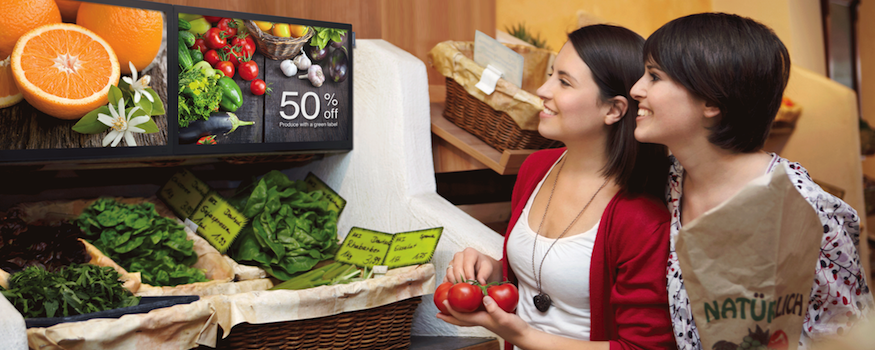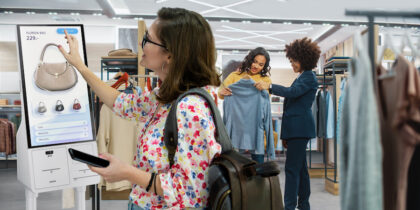Some of us have a remarkable ability to get in exactly the wrong checkout line at a grocery store, and get held up yet again as a shopper disputes the price at the cashier with the price they saw on the shelf label. Technology is coming to our rescue — in the form of smart grocery store signage.
Electronic shelf labels (ESLs) have evolved from dim gray tags to bigger, much brighter and colorful mini-signs that are mapped directly to store management systems, reading and showing the same information that comes up on checkout screens. So when store managers change the price on a particular brand of Dijon mustard, the price changes on shelves at the same moment it changes at the checkout lanes.
Making changes used to involve printing off labels that reflected the revised price and then sending staff out to swap those labels for the ones in place. Delays happen. People forget. The labels go in the wrong places. And the disputes and backups happen in the checkout lane. With smart grocery store signage, price changes happen instantly and accurately.
Pricing accuracy is obviously important. Selling at the wrong price can mean lost revenue if shoppers see higher prices than expected. Wrong prices can also affect morale — as neither staff nor the customer enjoys the process of sorting out what the real price is supposed to be.
Discover the TCO of Smart Signage
Learn about the cost savings achieved through Samsung's Smart Signage Platform in this white paper. Download Now
Bain & Company’s research on retail pricing found among approximately 2,200 consumers in Atlanta and Washington, that “best value” and “lowest prices” were two of the three most important factors in choosing a grocer. Bain also found clear and consistent price tags in the aisles stood out as a “powerful tactic for all grocers” — though it noted not everyone was doing a good job at it.
More Than The Price Is Right
The benefits of taking shelf labels digital extends beyond accuracy, though. The most obvious one is labor, particularly in environments like grocery stores, where there are many hundreds, or thousands, of different stocked items, or SKUs. Most grocers drive traffic into their stores week to week through sales promotions based on price — so staff need to get the right prices in the right places, during the right time periods. It’s not just about putting in new price labels, but as promotions lapses, removing the sales prices before the disputes start at checkouts.
Grocers also may need to change pricing frequently to meet or stay ahead of the competition, and smart grocery store signage enables them to change pricing on the fly. They can respond instantly to competitors’ promotions, set discounts on expiring or under-performing items, or respond to outside influences like weather to lower or raise prices.
For regional and national grocers, smart grocery store signage means they can remove the human factor out of planning and execution, and do things like variable pricing based on location with very high accuracy, from a desktop setup.
How ESLs Work
Early electronic shelf labels on the market were monochromatic screens reminiscent of early cellphone screens. They were small, and hard to see — but they did the basics — using low-cost, secure wireless networking to retrieve information from a central pricing system and show it on the screen. The little signs are made of electronic paper and each has a unique identity — making it possible to match a SKU and price to a screen at a specific location.
E-paper has come a long way since ESLs came on the market. The line of ESLs from Samsung spin-off SoluM, for example, comes in a variety of sizes — both monochromatic and supporting red as an eye-grabbing new color. The larger physical footprint on some products means more screen “real estate” to provide extra information. Mapped to point of sale and content management systems, some products are also showing shoppers:
-
Normal vs. sales price
-
Savings in dollars or percentages
-
Additional product information
-
Specific sale dates
-
Units in stock
-
Consumer ratings, such as a 4.5 out of 5
Because ESLs use e-paper, the carbon footprint of 100s or 1,000s of units around a grocery is minimal. They’re always visible, but only consume power in the fraction of a second it takes to refresh a screen with new information.
Going ESL
Smart grocery store signage at the shelf level has been around for 20-plus years, but the technology has matured and evolved, as has their position as a nice to have to a need to have. Online shopping and home delivery is changing the dynamics and choices for consumers, but the vast majority of grocery shopping is still done by consumers walking the aisles with a basket or cart. They have information in their hands, through their phones and they know they have other options.
But if they also know the prices they’re looking at are accurate and competitive, the easy decision is to make their purchases in that store.
Digital signage can provide a new level of customer interaction and engagement for your enterprise.








